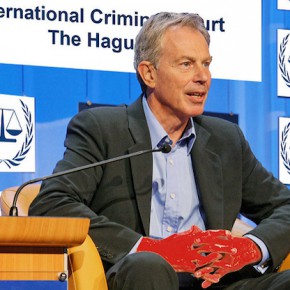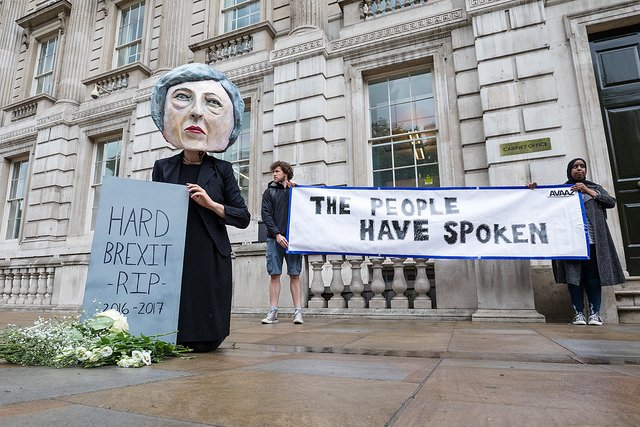Ahmadiyya Muslim Asad Shah was stabbed to death on March 24 outside of his shop on Minard Road, in Shawlands, Glasgow. Tanveer Ahmed, a 32-year-old taxi driver from Bradford, has been arrested for what has been reported as a religiously-motivated killing.
This article has been written after informal conversations with Asian Muslims in Glasgow and London, all of whom agree that the story is hardly that simple. Culpability extends beyond Ahmed himself, who murdered Shah in a context that begs to be understood.
The following is a rogue’s gallery that seeks to answer the question, “Who, and what, killed Asad Shah?”
Culprit A: Hating the Ahmadiyya
Following his arrest, Tanveer’s lawyer John Rafferty gave a detailed message that explained his motivations for the killing. “This all happened for one reason and no other issues and no other intentions,” he declared. “Asad Shah disrespected the messenger of Islam the Prophet Muhammad peace be upon him. Mr Shah claimed to be a Prophet. When 1400 years ago the Prophet of Islam Muhammad peace be upon him has clearly said that ‘I am the final messenger of Allah there is no more prophets or messengers from God Allah after me.’”
Tanveer appears to be fusing Asad with the spiritual leader Mirza Ghulam Ahmad, whose teachings form the core of the Ahmadiyya sect. Ahmad was born to a well-connected family in Qadian, Punjab, India, in 1835. By 1889, he had accumulated a small group of followers, and formally established the Ahmadiyya movement.
Ahmad claimed to have received divine instructions that he must lead an Islamic ethical revival as the Mahdi, and broke with the rigid dogmas of the ulema (Muslim religious scholars) by elaborating on the Prophet Muhammad’s stated position as the Khattan un-Nabiyyan (“the seal of all prophets.”)
Ahmad declared that while the Prophet Muhammad was the last prophet to deliver Islamic law, there could still be figures that arise to correct how those teachings have been articulated. His argument was that subordinate prophets could function within Muhammad’s “seal,” and that they serve an important role in guiding the Muslim community as it deviates from the original message.
Scholarly and non-scholarly critics have always been threatened by these positions, which cast doubt on basic claims about Islamic prophethood. As a result, Ahmaddiya Muslims are treated as an existential threat to the Muslim community, especially for Sunni Asian Muslims and their descendants. Tanveer’s statement that Asad “claimed to be a Prophet” must be taken through this history, because he seems to have fused Asad with the alleged deviancy of Ghulam Ahmed.
This could only be possible through the continued insistence that Ahmaddiya Muslims, through their mere existence, are aggressively damaging the standing of the Prophet Muhammad. It isn’t a huge leap for someone to then attack Asad as a threat to Islam more generally, especially when the classification of Ahmaddiya as “non-Muslim” is formalised in countries like Pakistan, Indonesia, and Saudi Arabia. All of these countries produce elites, and religious narratives, that are highly influential on British Muslim conservatives.
Culprit B: British Muslim Leaders
Numerous British Muslim leaders have played a major role in nurturing and extending exactly the prejudices that got Asad killed. Rather than using the killing as an opportunity to reassure the 25 000 Ahmaddiya Muslims in Britain of their inclusion in the larger number of 2.7 million, on April 6, the Muslim Council of Britain instead argued that:
The MCB Constitution requires our affiliates to declare that Messenger Muhammad peace be upon him is the final prophet and whoever does not subscribe to that declaration cannot be eligible for affiliation with the MCB. Given this fundamental theological difference with the Ahmadi community, the MCB is not in a position to represent or be represented by the Ahmadi community.
The MCB went further to act as though it was being victimised, noting that “pressure is mounting to describe this community as Muslim. Muslims should not be forced to class Ahmadis as Muslims if they do not wish to do so, at the same time, we call on Muslims to be sensitive, and above all, respect all people irrespective of belief or background.”
The latter is impossible in a situation where British Muslim leaders won’t take the critical step in defusing the prejudice: recognising that rather than there being a “fundamental theological difference,” Ahmadis simply adhere to a different reading of prophethood that can be religiously justified. They are Muslims.
Of course, if Ahmaddiya Muslims were recognised as such, the effect would be that organisations like the MCB would gradually begin to lose their monopoly on defining what Islam is, and how it is practiced. In that sense, the British ulema are as defensive as those in Ghulam Ahmad’s time. If Ahmadis were allowed to freely practice their beliefs and call themselves Muslims, then it would signal that Muslims have little to no obligation to the demands of a conservative ulema. This is an obvious and intolerable threat to their dominance.
Moreover, the MCB would get into an extended political fight with its membership, and it would have to answer uncomfortable questions about anti-Ahmadiyya prejudices in its ranks. For instance, if Ahmadis were considered Muslims, then the MCB would be forced to genuinely intervene in cases such as when violent anti-Ahmadiyya literature was found in a Stockwell Green mosque.
It would also have to account for why Khatme Nabuwwat, the publisher of the Stockwell booklets, and a group that is designed for the specific purpose of hating Ahmadis, was invited to a conference at Glasgow Central Mosque in August 2014.
The Glasgow Central Mosque is the largest and most influential mosque in Scotland, as evidenced by the fact that SNP First Minister Nicola Sturgeon observed a one-minute silence there after the Paris Attacks in November. It is trusted as being representative of Scottish Muslims, and certainly has the resources to pursue that role. It is worth asking serious questions about whether the mosque’s leadership (predominantly Sunni, and either Pakistani or of Pakistani descent) is willingly reproducing anti-Ahmadi sentiment.
This is especially important since it has been linked to violent conservatism in other cases. Imam Maulana Habib Ur Rehman recently came under fire for praising Mumtaz Qadri, a bodyguard who killed Punjab Governor Salman Tahseer in 2011 for his opposition to the blasphemy law. After Qadri’s execution in February, Rehman said over WhatsApp that he “cannot hide his pain,” and that “a true Muslim was punished for doing which the collective will of the nation failed to carry out.”
Rehman’s stance as a leader of Glaswegian Muslims is worrying. It is worth noting that after Scottish Ahmadi Muslims launched a United Against Extremism campaign following Shah’s death, the Glasgow Central Mosque didn’t even send a representative. Neither did the Muslim Council of Scotland.
Culprit C: Islamophobia
The entire reason that there is so much anxiety over Ahmadiyya Muslims like Asad is because the British Muslim community feels pressured by wider society. One of the effects of Islamophobia is that Muslims feel more insecure about their identities, and as a result, they are more likely to lash out against potential threats. Why else would Tanveer care so much about the fact that Asad was allegedly a “false prophet” that was threatening Islam?
Troublingly, rather than being critically explored, Islamophobia has been extended through Asad’s death. It is telling that numerous columnists have reported on Asad’s posting of an Easter greeting to Facebook. This has been presented either explicitly, or implicitly as a motivation for Tanveer, in outlets like BBC News, The Guardian, and The Spectator.
It is possible that the Easter greeting has been noted repeatedly in order to emphasise the warmth of Asad’s character. However, without context, it obviously implies that Asad was killed by a Sunni radical for his multicultural attitudes. This in spite of the fact that Tanveer explicitly states, “I wish to make it clear that the incident has nothing at all to do with Christianity or any other religious beliefs,” instead accusing Asad of calling himself a prophet. “Even though I am a follower of the Prophet Muhammad (Peace Be Upon Him) I also love and respect Jesus Christ.”
It is reasonable to conclude that the Islamophobic impulses of established journalists resulted in news stories that played to the narrative of Muslim extremists being a violent threat to ‘good minorities’ that tolerate and celebrate Anglican and Presbyterian Christianity.
The danger is that Ahmadis are classified as being the only Muslims that are ‘peace-loving’ and worthy of protection. Douglas Murray, Associate Director of the Henry Jackson Society, went so far as to argue that “in Britain whenever there is a vaguely positive news story about Islam it almost invariably involves Ahmadi Muslims.”
Murray’s reading of the situation seems to be that Ahmadis deserve special protections almost exclusively because of their adherence to ‘British Values.’ In this vein, the portrayal of Asad as “peace-loving,” with the non-Ahmadiya Tanveer being portrayed as the opposite, has served the purpose of intensifying the scrutiny of British Muslims in general.
Those are the culprits. Tanveer killed Asad in a context of toxic sectarian hatred, either inaction or complicity from British Muslim leaders, and accelerating Islamophobia in wider society. Tanveer is the only one that will be charged, but if those other factors weren’t there, then the murder could not have happened.
Screenshot courtesy of the BBC/YouTube. All rights reserved.





